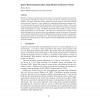Free Online Productivity Tools
i2Speak
i2Symbol
i2OCR
iTex2Img
iWeb2Print
iWeb2Shot
i2Type
iPdf2Split
iPdf2Merge
i2Bopomofo
i2Arabic
i2Style
i2Image
i2PDF
iLatex2Rtf
Sci2ools
112
Voted
CLIN
2004
2004
Query-Based Summarization using Rhetorical Structure Theory
Research on Question Answering is focused mainly on classifying the question type and finding the answer. Presenting the answer in a way that suits the user's needs has received little attention. This paper shows how existing question answering systems--which aim at finding precise answers to questions--can be improved by exploiting summarization techniques to extract more than just the answer from the document in which the answer resides. This is done using a graph search algorithm which searches for relevant sentences in the discourse structure, which is represented as a graph. The Rhetorical Structure Theory (RST) is used to create a graph representation of a text document. The output is an extensive answer, which not only answers the question, but also gives the user an opportunity to assess the accuracy of the answer (is this what I am looking for?), and to find additional information that is related to the question, and which may satisfy an information need. This has been i...
CLIN 2004 | Computational Linguistics | Question Answering | Question Answering Modules | Question Type |
Related Content
| Added | 30 Oct 2010 |
| Updated | 30 Oct 2010 |
| Type | Conference |
| Year | 2004 |
| Where | CLIN |
| Authors | Wauter Bosma |
Comments (0)

